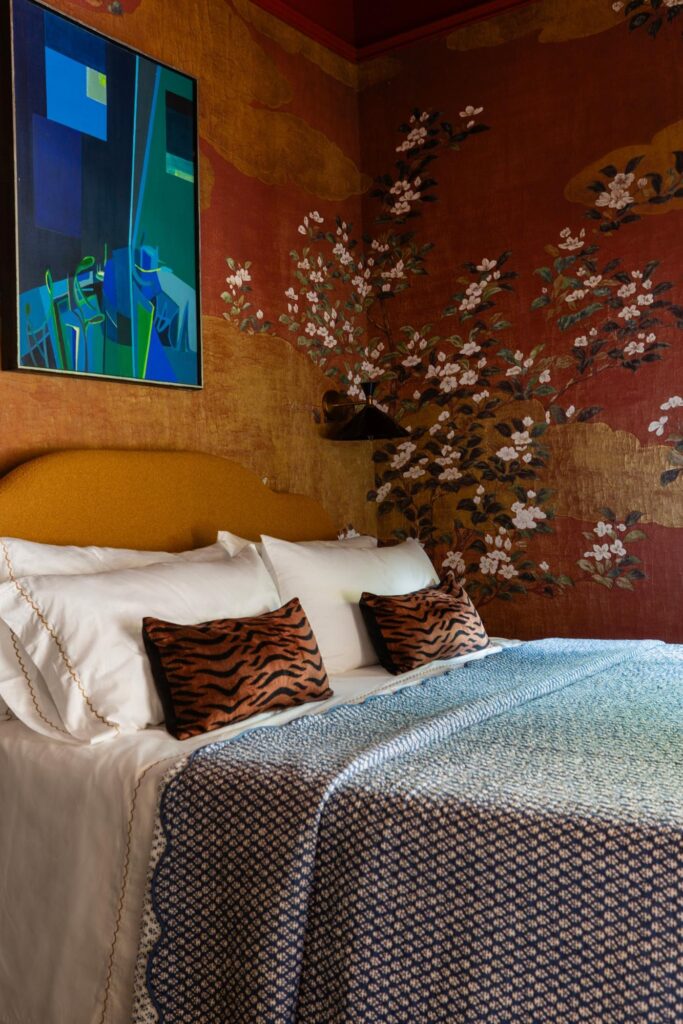Top five ways to balance calm and chaos in your house.
By Hannah Nuñez

For many, creating an environment centered around relaxation involves minimalist designs and serene layouts. For Austin interior designer, Sarah Stacey, calm could not look more different.
Founded in 2010, Sarah Stacey Interior Designs has been loyally devoted to merging functionality with personality. Rather than stick to simplicity, the studio embraces a menagerie of bold colors, antiques and everything maximalist. By taking this eclectic route, Stacey is pushing the boundaries of how we commonly perceive calm by navigating the fine line between too much and just enough. Stacey shares her maximalist guide to balancing calm and chaos within a space.
Incorporate Colors and Patterns

It’s easy to be intimidated by the intensity that bright colors and vivid patterns have to offer, but when used correctly these elements can completely sway the feel of a room. “Colors impact mood in profound ways. Rich, deep tones evoke a sense of comfort and coziness, while brighter colors can lift the mood and energy of a space,” says Stacey. “The key is balancing the saturation and tone to align with how you want the room to feel.”
When seeking a more laid-back mood, look to nature for inspiration; shades of green and blue can ground a space without dulling it. If a spirited environment is more your speed, incorporating patterns may come in handy. “I recommend committing to [patterns]in a large way-whether through drapery, upholstering a chair, or even just the cushions of your sofa,” says Stacey. “Choose a pattern you truly love, and make sure it compliments the other pieces in the space, so it feels like a natural part of the design rather than an afterthought.”
Play with Scale and Proportion

If zebra print isn’t exactly your style, manipulating scale is a subtle way to add a bit of whimsy to a space. Properly implementing scale and proportion to a home can turn your living room into an enchanting optical illusion. “Start with items that aren’t necessary for everyday comfort,” says Stacey.
Often this can easily be done by playing with the size of accent pieces like large artwork or lamps. “Oversize these pieces to introduce an element of fun without disrupting the overall comfort of the room,” Stacey explains. “This way you can experiment with scale without feeling overwhelmed or uncomfortable.”
Add in Textures and Textiles

Leather, wool, cotton–textiles take the feel of a room to a whole new meaning. “Texture and textiles are fundamental to creating a layered, cozy environment,” Stacey says.
Whether you prefer smooth satin pillows or coarse wicker baskets, the physical feel of a space will only act as an addition to the overall energy. “Velvet is a favorite of mine, as is corduroy; they’re both incredibly soft,” says Stacey. “There’s just something about the texture that feels inviting and adds comfort to a space.”
Cue Up the Lighting

Life can look a lot different under fluorescents. This is why Stacey is a proud follower of the “no big light” rule. By reaching for lamps rather than light switches, Stacey is swapping a sterile scene for a multilayered cozy atmosphere. “Overhead lighting tends to be harsh and flatten out a room while layering softer light sources creates a more inviting space,” says Stacey. “A mix of table lamps, floor lamps, and sconces creates an atmosphere that overhead lights often cannot provide.”
While utilizing soft lighting is a great way to deepen the mood, light fixtures can elevate a space with personality. “Whether it’s a statement chandelier or a sculptural floor lamp, the light fixture can act as both a practical and aesthetic focal point, affecting the room’s vibe,” shares Stacey.
Leave a Personal Touch
Above all else, the foundation of a space is based upon the energy we bring into it. While maximalists have a reputation for being nostalgic, incorporating pieces with personal meaning can sprinkle life’s best moments around a space. “I want people to feel connected to their homes and sometimes that comes down to the small details,” says Stacey.
A bit of nostalgia can sometimes be the glue a room needs to be held together. Stacey recently suggested a client incorporate their love of antiques into their home for a personal connection. “I encouraged them to attend auctions and find pieces they themselves deeply connected with,” says Stacey. “They loved the experience so much that a majority of the pieces in their home now hold a charming backstory.



3 Comments
Very well written, I enjoyed reading this!
You’ve covered this subject very thoroughly—great job!
Thanks for providing such valuable insights in this post.